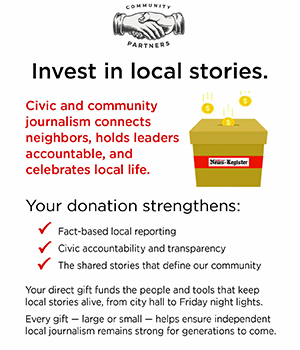Davis and Gunn: Never too early to plant a local vegetable garden
The days are slowly getting longer and warmer — enough so that we will soon see the primrose and daffodil blooming. A garden puts you in the natural cycle of growth and change, so the first signs of spring bring hope.
Gardening efforts of all sizes abound in this community. There is the large community garden north of town, the Linfield student garden, the traditional backyard plots, the raised garden beds showing up in front yards and the single pot growing on front porches.
Start small. As your skills increase, you can expand.
You know the land around McMinnville is good for growing food when you see all the farming activities being supported: farmers’ markets, CSAs, produce stands and u-pick operations.
The urban growth boundary dispute was essentially about how much of that high-quality farmland should be paved over for streets and housing. And yes, you too can take advantage of that soil to grow food.
We have been gardening together for more than 40 years.
Peas can be planted in February, so now is the time to be planning your garden. Here are a few suggestions to get you started:
Where?
As a general rule, you should locate your garden in the area where sunlight is most plentiful and the soil drains the winter rains away most quickly, as nothing discourages new seedlings more than cold, soggy roots.
Raised beds promote drainage and reduce bending over, so build permanent ones or heap soil to create temporary ones.
While the soil in this area is generally good, it can always be improved by adding compost. You can buy compost locally, but you should also start your own compost heap, as the garden itself produces plenty of compostable material — everything you don’t haul in the house to eat.
If weeds aren’t growing where you want to plant your garden, it probably isn’t going to grow vegetables either. If you garden every year, you will want to plant a cover crop like annual ryegrass in the fall to crowd out the weeds and protect the soil from the pounding winter rain.
When?
Garden vegetables have evolved from different ecosystems all over the world, so there is not a single date that is best for everything. Consult seed packets, online sources, seed catalogs and experienced neighbors for advice on timing. And remember, raised beds warm the soil, making earlier planting realistic.
It's important to differentiate the planting times of crops that produce all season from a single planting (e.g., tomatoes, peppers, summer squash and chard) from those that are harvested in their entirety, need to replanted every few weeks to ensure a constant supply (e.g., lettuce, spinach, carrots and beets). Either save a row to put in future crops or replant areas you have already harvested.
With the onset of global warming, it is now much easier to grow vegetables in the winter. This is a factual observation, not an endorsement of global warming, which will bring economic ruin to billions of people if it is not halted. Growing your own food is, in fact, a small way you can help cool the planet.
In the past two months, we have harvested lettuce, spinach, carrots, leeks, broccoli, cauliflower, cabbage, brussel sprouts and various winter-hardy greens like chard and kale. All of these crops were planted during the summer, so planning ahead is critical for winter harvest.
What?
The best crops to plant in your garden are the ones you and your family most enjoy eating. If you are just starting out, choose your five favorite vegetables among those that grow well in Oregon. Here are five of our favorites:
1) Lettuce
There are varieties available to grow in every season, featuring all sorts of leaves in various shades of red and green. Lettuce can be direct-seeded or transplanted from starts you grow in a cold frame or greenhouse.
2) Cucumbers
Direct-seeded in May, you can harvest them from July into October. There are many traditional green varieties to choose from, but we are partial to round yellow lemon cucumbers.
3) Tomatoes
There has been an explosion of tomato varieties, giving you numerous hybrids and heirlooms to choose from in all kinds of sizes, shapes and colors. If you have room, plant some of the sauce varieties, like Roma, and make your own tomato sauce.
4) Sweet peppers
Our favorite variety is Gypsy. For any pepper, please don’t pick them green like commercial growers do for the stores. Wait for them to ripen, turning a bright red in the case of Gypsy, and enjoy their full, sweet flavor. Any excess can be dried or frozen for later use.
5) Kale
This cold-hardy greens crop survives even the week-long hard freezes we used to get in Western Oregon. We prefer the milder flavor of the Red Russian variety.
How
It's generally best to plant seeds at a depth twice their diameter, so smaller seeds need a light covering of soil and larger ones are better served with a thicker layer of soil. If you are transplanting starts you have grown or purchased, you typically want to plant them about the same level as the pot they were grown in.
Ideally, you should plant just before a gentle, soaking rain. Absent that, emulate that type of rain with a sprinkler or nozzle.
Once the plants are established, we highly recommend investing in drip irrigation. You pay for less water and put the water right where the plants need it, not between rows where the weeds grow.
For crops that are going to be around for several months, we typically mulch with straw. Mulch conserves water, suppresses weeds and eventually decomposes to improve the soil for the following year.
Yes, you do need to weed, even when you use mulch. Make it a weekly chore and you will keep up.
Unless you transplant everything with exact spacing, you will need to thin the new growth to get proper spacing. That will encourage them to grow to full size.
If you plant in fertile soil at the right time, with proper watering, your crops will grow optimally. They will display limited insect damage.
We are organic growers, so generally handpick pests. Cole crops, from the cabbage family, are especially susceptible, so we use row covers and always plant a few extra to allow for the inevitable root maggot damage.
The biggest threat to gardens here in town is the deer population. We tried all the folk remedies before eventually opting to fence the garden to keep them out.
Summary
Gardening brings delights — the first ripe tomato, a basketful of salad greens, delicious cantaloupes and a place to create beauty near your home.
Food doesn’t get any fresher or more nutritious. You know exactly what was sprayed on it, or hopefully not, and it tastes great.
For more information on gardening, we all hope the local Master Gardeners will soon be able to get out in public to give advice, as they have in years past. In the interim, check out the Oregon State Extension Service at https://extension.oregonstate.edu/gardening.













Comments
leo
I know they meant it's never too early to PLAN a garden. It is too early to plant anything outside.
Don Dix
Nice article!
Tomato starts should be planted after the last average freeze. Locally that would be the first week of May.
I use half barrels, on pavement, southern exposure, and a white background.
After planting several types, hybrid and heirloom, the Willamette stands out. It was developed by OSU to grow in this valley climate. Not a large fruit, but slicing creates little 'fallout' and it's full of flavor.
Two seasons ago (2018), my plants began producing mid-July and lasted a full 3 months. Multi-weekly deliveries to the bank, dentist office, coffee shops, and family and friends became a challenge. Normally my plants produce around 400 - 500 tomatoes yearly (always 3 plants). A documented count that year (2018) was 797 tomatoes (bumper crop).
It's not difficult to garden, but care and attention is an important aspect.
Happy gardening!